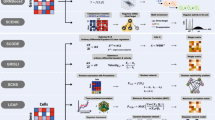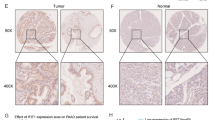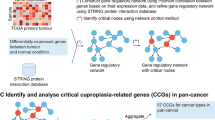Abstract
Objective
The objective of this study was to discover potential cancer-related genes involved in retinoblastoma (RB) tumorigenesis.
Materials and methods
Using a data-mining tool called cDNA Digital Gene Expression Displayer (DGED) and serial analysis of gene expression DGED from the Cancer Genome Anatomy Project (CGAP) database, eight cDNA libraries and five serial analysis of gene expression libraries from retinoblastoma (RB) solid tumors and normal retina tissues were analyzed. The deregulated genes were classified into major families using information from Gene Ontology. Several candidate cancer-related genes were analyzed by real-time reverse transcription polymerase chain reaction (RT-PCR) and immunohistochemistry (IHC) on tissue microarrays (TMA) of RB and human normal retina samples.
Results
A total of 260 genes with deregulated expression emerged when examined by DGED from the CGAP database. Functional classification of these genes not only provided an interesting insight into RB tumorigenesis but also facilitated target identification for RB therapeutics. Several candidate genes were confirmed by real-time RT-PCR and IHC analysis on TMA and were found to be associated with RB genesis through text-mining in Information Hyperlinked over Proteins. The results also implicated MCM7 and WIF1 as promising therapeutic targets for RB, but further validation is needed.


Similar content being viewed by others
References
Dyer MA, Rodriguez-Galindo C, Wilson MW (2005) Use of preclinical models to improve treatment of retinoblastoma. PLoS Med 2:e332 DOI 10.1371/journal.pmed.0020332
Dunn JM, Phillips RA, Becker AJ, Gallie BL (1988) Identification of germline and somatic mutations affecting the retinoblastoma gene. Science 241:1797–1800
Valverde JR, Alonso J, Palacios I, Pestaña AJ (2005) RB1 gene mutation up-date, a meta-analysis based on 932 reported mutations available in a searchable database. BMC Genet 6:53 DOI 10.1186/1471-2156-6-53
Corson TW, Gallie BL (2007) One hit, two hits, three hits, more? Genomic changes in the development of retinoblastoma. Genes Chromosomes Cancer 46:617–634 Review
Strausberg RL, Dahl CA, Klausner RD (1997) New opportunities for uncovering the molecular basis of cancer. Nature Genet 15:415–416
Strausberg RL, Buetow KH, Emmert-Buck MR, Klausner RD (2000) The cancer genome anatomy project: building an annotated gene index. Trends Genet 16:103–106
Strausberg RL, Greenhut SF, Grouse LH, Schaefer CF, Buetow KH (2001) In silico analysis of cancer through the Cancer Genome Anatomy Project. Trends Cell Biol 11:S66–71 Review
Loging WT, Lal A, Siu IM, Loney TL, Wikstrand CJ, Marra MA, Prange C, Bigner DD, Strausberg RL, Riggins GJ (2000) Identifying potential tumor markers and antigens by database mining and rapid expression screening. Genome Res 10:1393–1402
Scheurle D, DeYoung MP, Binninger DM, Page H, Jahanzeb M, Narayanan R (2000) Cancer gene discovery using digital differential display. Cancer Res 60:4037–4043
Dennis JL, Vass JK, Wit EC, Keith WN, Oien KA (2002) Identification from public data of molecular markers of adenocarcinoma characteristic of the site of origin. Cancer Res 62:5999–6005
Yanglin P, Lina Z, Zhiguo L, Na L, Haifeng J, Guoyun Z, Jie L, Jun W, Tao L, Li S, Taidong Q, Jianhong W, Daiming F (2007) KCNE2, a down-regulated gene identified by in silico analysis, suppressed proliferation of gastric cancer cells. Cancer Lett 246:129–138
Chakraborty S, Khare S, Dorairaj SK, Prabhakaran VC, Prakash DR, Kumar A (2007) Identification of genes associated with tumorigenesis of retinoblastoma by microarray analysis. Genomics 90:344–353
Zeng Z, Zhou Y, Xiong W, Luo X, Zhang W, Li X, Fan S, Cao L, Tang K, Wu M, Li G (2007) Analysis of gene expression identifies candidate molecular markers in nasopharyngeal carcinoma using microdissection and cDNA microarray. J Cancer Res Clin Oncol 133:71–81
Hoffmann R, Valencia A (2004) A gene network for navigating the literature. Nat Genet 36:664
Chou CC, Davis RC, Fuller ML, Slovin JP, Wong A, Wright J, Kania S, Shaked R, Gatti RA, Salser WA (1987) Gamma-actin: unusual mRNA 3'-untranslated sequence conservation and amino acid substitutions that may be cancer related. Proc Natl Acad Sci U S A 84:2575–2579
Liau SS, Jazag A, Whang EE (2006) HMGA1 is a determinant of cellular invasiveness and in vivo metastatic potential in pancreatic adenocarcinoma. Cancer Res 66:11613–11622
Chiappetta G, Botti G, Monaco M, Pasquinelli R, Pentimalli F, Di Bonito M, D’Aiuto G, Fedele M, Iuliano R, Palmieri EA, Pierantoni GM, Giancotti V, Fusco A (2004) HMGA1 protein overexpression in human breast carcinomas: correlation with ErbB2 expression. Clin Cancer Res 10:7637–7644
Giannini G, Cerignoli F, Mellone M, Ambrosi C, Rinaldi C, Dominici C, Frati L, Screpanti I, Gulino A (2005) High mobility group A1 is a molecular target for MYCN in human neuroblastoma. Cancer Res 65:8308–8316
Facoetti A, Ranza E, Grecchi I, Benericetti E, Ceroni M, Morbini P, Nano R (2006) Immunohistochemical evaluation of minichromosome maintenance protein 7 in astrocytoma grading. Anticancer Res 26:3513–3516
Ren B, Yu G, Tseng GC, Cieply K, Gavel T, Nelson J, Michalopoulos G, Yu YP, Luo JH (2006) MCM7 amplification and over expression are associated with prostate cancer progression. Oncogene 25:1090–1098
Li SS, Xue WC, Khoo US, Ngan HYS, Chan KYK, Tam IYS, Chiu PM, Ip PPC, Tam KF, Cheung ANY (2005) Replicative MCM7 protein as a proliferation marker in endometrial carcinoma: a tissue microarray and clinicopathological analysis. Histopathology 46:307–313
Brake T, Connor JP, Petereit DG, Lambert PF (2003) Comparative analysis of cervical cancer in women and in a human papillomavirus-transgenic mouse model: identification of minichromosome maintenance protein 7 as an informative biomarker for human cervical cancer. Cancer Res 63:8173–8180
Shohet JM, Hicks MJ, Plon SE, Burlingame SM, Stuart S, Chen SY, Brenner MK, Nuchtern JG (2003) Minichromosome maintenance protein MCM7 is a direct target of the MYCN transcription factor in neuroblastoma. Cancer Res 62:1123–1128
Falini B, Nicoletti I, Bolli N, Martelli MP, Liso A, Gorello P, Mandelli F, Mecucci C, Martelli MF (2007) Translocations and mutations involving the nucleophosmin (NPM1) gene in lymphomas and leukemias. Haematologica 92:519–532 Review
Jeong EG, Lee SH, Yoo NJ, Lee SH (2007) Absence of nucleophosmin 1 (NPM1) gene mutations in common solid cancers. APMIS 115:341–346
Leys CM, Nomura S, LaFleur BJ, Ferrone S, Kaminishi M, Montgomery E, Goldenring JR (2007) Expression and prognostic significance of prothymosin-alpha and ERp57 in human gastric cancer. Surgery 141:41–50
Suzuki S, Takahashi S, Takahashi S, Takeshita K, Hikosaka A, Wakita T, Nishiyama N, Fujita T, Okamura T, Shirai T (2006) Expression of prothymosin alpha is correlated with development and progression in human prostate cancers. Prostate 66:463–469
Satoh K, Narumi K, Sakai T, Abe T, Kikuchi T, Matsushima K, Sindoh S, Motomiya M (1992) Cloning of 67-kDa laminin receptor cDNA and gene expression in normal and malignant cell lines of the human lung. Cancer Lett 62:199–203
Sun B, Zhang S, Zhang D, Liu Y, Li Y, Rong Z, Zhu Y, Jia X (2007) Clusterin is associated with spontaneous breast cancer in TA2 mice. FEBS Lett 581:3277–3282
Mourra N, Couvelard A, Tiret E, Olschwang S, Flejou JF (2007) Clusterin is highly expressed in pancreatic endocrine tumours but not in solid pseudopapillary tumours. Histopathology 50:331–337
Qu Y, Li JF, Cai Q, Wang YW, Gu QL, Zhu ZG, Liu BY (2007) Over-expression of FRZB in gastric cancer cell suppresses proliferation and induces differentiation. J Cancer Res Clin Oncol 134(3):353–364
Zeng ZY, Zhou YH, Zhang WL, Xiong W, Fan SQ, Li XL, Luo XM, Wu MH, Yang YX, Huang C, Cao L, Tang K, Qian J, Shen SR, Li GY (2007) Gene expression profiling of nasopharyngeal carcinoma reveals the abnormally regulated Wnt signaling pathway. Hum Pathol 38:120–133
Queimado L, Lopes CS, Reis AM (2007) WIF1, an inhibitor of the Wnt pathway, is rearranged in salivary gland tumors. Genes Chromosomes Cancer 46:215–225
Ai L, Tao Q, Zhong S, Fields CR, Kim WJ, Lee MW, Cui Y, Brown KD, Robertson KD (2006) Inactivation of Wnt inhibitory factor-1 (WIF1) expression by epigenetic silencing is a common event in breast cancer. Carcinogenesis 27:1341–1348
Taniguchi H, Yamamoto H, Hirata T, Miyamoto N, Oki M, Nosho K, Adachi Y, Endo T, Imai K, Shinomura Y (2005) Frequent epigenetic inactivation of Wnt inhibitory factor-1 in human gastrointestinal cancers. Oncogene 24:7946–7952
Lin YC, You L, Xu Z, He B, Mikami I, Thung E, Chou J, Kuchenbecker K, Kim J, Raz D, Yang CT, Chen JK, Jablons DM (2006) Wnt signaling activation and WIF-1 silencing in nasopharyngeal cancer cell lines. Biochem Biophys Res Commun 341:635–640
Tell S, Yi H, Jockovich ME, Murray TG, Hackam AS (2006) The Wnt signaling pathway has tumor suppressor properties in retinoblastoma. Biochem Biophys Res Commun 349:261–269
Xu H, Wang C, Zhu H, Liu S, Xu X, Jiang Y (1995) Characteristics of an established retinoblastoma cell line HXO-Rb44. Yan Ke Xue Bao 11:16–21
Schulz HL, Goetz T, Kaschkoetoe J, Weber BH (2004) The retinome—defining a reference transcriptome of the adult mammalian retina/retinal pigment epithelium. BMC Genomics 5(1):50 DOI 10.1186/1471-2164-5-50
Semizarov D, Kroeger P, Fesik S (2004) siRNA-mediated gene silencing: a global genome view. Nucleic Acids Res 32:3836–3845
Sterner JM, Dew-Knight S, Musahl C, Kornbluth S, Horowitz JM (1998) Negative regulation of DNA replication by the retinoblastoma protein is mediated by its association with MCM7. Mol Cell Biol 18:2748–2757
Chau KY, Munshi N, Keane-Myers A, Cheung-Chau KW, Tai AK, Manfioletti G, Dorey CK, Thanos D, Zack DJ, Ono SJ (2000) The architectural transcription factor high mobility group I(Y) participates in photoreceptor-specific gene expression. J Neurosci 20:7317–7324
Acknowledgements
We thank the patients and corneal donors for their participation in this study. This work was supported in part by the National Basic Research Program of China (2007CB5119005), National Natural Science Foundation of China (30471867), the Program for Innovative Researcher Team in Science and Technology in Fujian Province University (FMU-RT001), Fujian Provincial Natural Science Foundation (C0510009, C0520003), and Science Development Foundation of Fujian Medical University (FJGXY04020).
Conflict of interest statement
The authors declare that they have no competing interests.
Author information
Authors and Affiliations
Corresponding authors
Additional information
Juhua Yang and Jian-Jun Zhao contribute equally to the article.
Electronic supplementary material
Below is the link to the electronic supplementary material.
ESM
(DOC 630 kb)
Rights and permissions
About this article
Cite this article
Yang, J., Zhao, JJ., Zhu, Y. et al. Identification of candidate cancer genes involved in human retinoblastoma by data mining. Childs Nerv Syst 24, 893–900 (2008). https://doi.org/10.1007/s00381-008-0595-7
Received:
Published:
Issue Date:
DOI: https://doi.org/10.1007/s00381-008-0595-7




